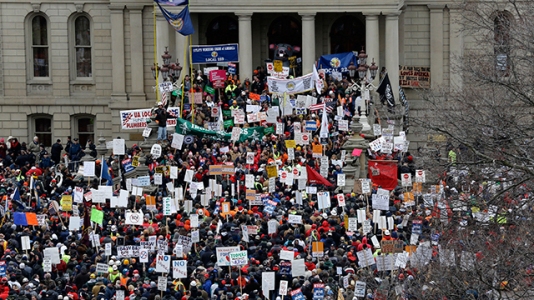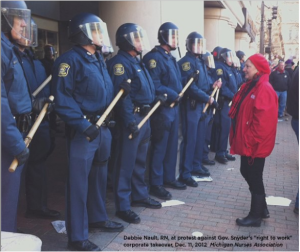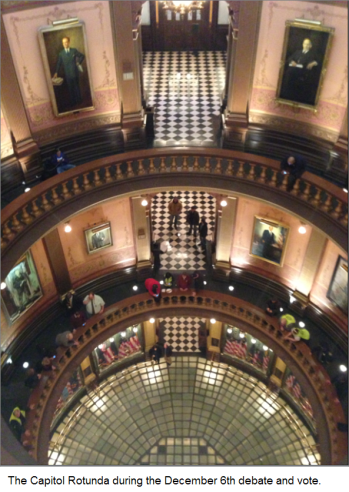 Beginning with his campaign for Governor in 2009, Rick Snyder repeatedly assured the state that Right to Work was “not on my agenda.” This now infamous comment was made during the campaign, was repeated throughout his term as Governor, and suddenly changed after the 2012 election.
Beginning with his campaign for Governor in 2009, Rick Snyder repeatedly assured the state that Right to Work was “not on my agenda.” This now infamous comment was made during the campaign, was repeated throughout his term as Governor, and suddenly changed after the 2012 election.
During that election, his promise was especially meaningful. This election cycle included Proposal 2, a union-initiated question to add collective bargaining protection to the Michigan Constitution. Governor Snyder’s assurances that Right to Work was wrong for Michigan during the Proposal 2 campaign served to allay the fears of independent voters, voters that leaned against what they had come to believe was an unnecessary constitutional amendment, unnecessary due to the near certainty that the Governor would never support a Right to Work law.
This reliance on the Governor’s word proved to be misplaced when he announced on December 5, 2012, that Right to Work was “on the table.” This announcement was made during the Michigan legislature’s “lame duck” session, a short period between the November election and the start of the next legislative session the following January. Lame duck sessions are often a party’s last chance to move controversial legislation and only occur in Michigan and five other states.
The Governor’s explanation for this reversal has varied. He at first stated that it was retribution to the unions for proposing a constitutional amendment. The Detroit Free Press reported: “The governor did say that there are ramifications to the decision by labor leaders to proceed against his urgings with an unsuccessful ballot initiative…”
He later justified his reversal as a way to give “freedom of choice to workers” and avoid discord. Soon after the bills were forced through the legislature, they were justified as a way to draw new businesses into the state, because lower wages meant “higher potential profits.” Rumors suggested instead that he had been promised a well-financed primary opponent, Attorney General Bill Schuette, if he refused to sign a Right to Work bill.
The next day, December 6th, 12,000 union supporters arrived at the Capitol to oppose the bill. At noon, a press conference was held in the Governor’s office, located in the George W. Romney Building, directly across the street from the Capitol Building. This caused the near evacuation of the Capitol as the crowd moved to fill the streets surrounding the Romney building.
The resulting State Police presence cost $901,132. The Michigan State Police enjoy a constitutionally protected right to bargain, a right they won after sponsoring a ballot measure nearly identical to Proposal 2 in 1978.
Inside the Romney building, Governor Snyder announced his intention to sign a Right to Work bill. At the same time, after a skirmish outside the Senate floor, the Capitol was locked. Although the building was nearly empty, it remained closed for 4 hours in order to protect “the Capitol’s structural integrity.” During the time that the demonstrators were locked out of the building, House Republicans discharged a labor law bill from committee, avoiding hearings and committee votes, and then substituted the full text of the Right to Work legislation in place of the bill’s original language. The bill was then put to a vote and passed without Democratic support.
This occurred while the House galleries were packed by Republican legislative staffers in order to exclude those few demonstrators who remained in the building.
Later in the afternoon, the MEA was granted an injunction ordering that the building be unlocked. The House Republican leadership refused, stating that they were not bound by such a court order. The order was ignored until the House Democratic caucus left the building, refusing to return until it was unlocked.
The House Republican leadership refused, stating that they were not bound by such a court order. The order was ignored until the House Democratic caucus left the building, refusing to return until it was unlocked.
Five days later, on December 11th, the bill received final passage in the Senate. This day was chosen in order to satisfy the Michigan Constitution’s “five day rule.” That article provides that every bill before the legislature must be: “printed or reproduced and in the possession of each house for at least five days.”
While the bill had been pending before the Senate for exactly five days, the same hadn’t been true in the House. The process of discharging a labor law bill and substituting the Right to Work language into it, followed by final passage several hours later only satisfied the five day rule in a technical sense, in that a bill with the same number, HB 4054, had been pending in the House for more than five days.
Many factors led to the sudden move to enact the bills. The recall of Rep. Paul Scott and the attempt to enact Proposal 2 served to anger the Republican leadership. In addition, five House Republicans who were defeated in the November election were eager for revenge. Short-circuiting the legislative process in lame duck was all the more urgent because there would be five fewer Republicans in the next legislative session.
Finally, when the support of a small number of Republicans wavered, local police and firefighters were exempted from the bill in exchange for their vote. Those that remained opposed were promised a primary challenge financed by the Devos family unless they voted yes. A promise delivered in person by Betsy Devos.
The resulting legislation bars referendums that would allow a public vote to reverse its provisions. The legislature included a largely symbolic appropriation in order to take advantage of a constitutional bar against referendums of appropriation bills. It also requires that lawsuits be filed in the Court of Appeals rather than the Court of Claims, where all other litigation involving the state is filed. Unlike the Court of Claims, the Governor appoints Court of Appeals judges.
In the final hours of the lame duck session, the legislature and governor finalized a bill to heavily restrict recall elections. The primary feature of this new restriction is to require that the Board of Canvassers approve the accuracy of every recall petition. Previously, reviews were limited to the petition format only. Because the Board is made up of equal numbers of Republicans and Democrats, such approval is certain to fail.
The actions taken during the 2012 lame duck session represent a historic subversion of the legislative process:
- The entire process took 2 days, 5 days apart, although the Michigan Constitution requires that each house consider a bill for 5 days;
- The legislation passed with no public hearings and with voting taking place while the Capitol building was locked;
- Republican staffers were told to pack the galleries in order to exclude those still in the building;
- The resulting Act bars public referendums on the law;
- The Act requires lawsuits be filed in courts whose judges are appointed by the Governor;
- A separate bill was enacted that heavily restricts any recall petitions filed as a result of the legislation.
